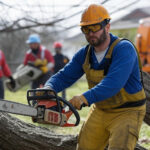Storm Damage
Trees, while beautiful and beneficial to the environment, can become major hazards during severe weather events. Whether through high winds, heavy rain, or ice, storm damage can cause serious harm to trees, leading to potential property damage and safety concerns. Tree services are crucial for preventing such issues, as well as providing emergency assistance after a storm. From routine care to storm recovery, tree professionals ensure the health and stability of trees, protecting homes and landscapes from the dangers that come with extreme weather conditions.
The Role of Regular Tree Care
Routine tree maintenance plays a significant part in minimizing storm-related damage. Trees that are regularly pruned, inspected, and treated are more resilient in the face of adverse weather. Professional tree services can identify potential risks, such as dead limbs, root rot, or weakened branches, before they become serious threats.
Regular pruning reduces a tree’s wind resistance, preventing it from becoming too heavy or unbalanced. This simple act can reduce the likelihood of the tree breaking or toppling in high winds. Additionally, maintaining proper root health through fertilization and care ensures the tree remains securely anchored in the soil, even during heavy rains or flooding.
Tree experts also assess trees for signs of disease or decay. Weaknesses in a tree’s structure, such as internal rot or fungal infections, can go unnoticed until a storm causes catastrophic failure. Proactively addressing these issues prevents accidents and helps keep the tree strong and healthy.
Common Types of Storm Damage
Storms come in many forms, and the type of weather determines how trees may be damaged. Below are some common weather events and their effects on trees:
Wind Damage: High winds, especially during hurricanes or tornadoes, are notorious for causing tree damage. Branches may break, trunks can split, and entire trees may be uprooted. Wind-damaged trees often show signs of stress beforehand, such as leaning or loose soil around the base, making it essential to monitor them regularly.
Rain and Flooding: Heavy rainfall can lead to soil saturation, weakening tree roots. In extreme cases, trees may be uprooted, especially if they already have shallow roots or are planted in poorly draining areas. Over time, waterlogged soil can suffocate roots, leading to long-term tree health issues or death.
Lightning Strikes: Tall trees are natural lightning rods. When a tree is struck by lightning, the intense heat causes the sap inside to vaporize, often resulting in split bark or exploded limbs. Lightning damage can leave trees vulnerable to decay, disease, and eventual structural failure.
Ice and Snow: In colder climates, ice accumulation on branches and heavy snow can cause branches to snap. The weight of the ice can even cause entire trees to fall. Tree services can help by pruning back branches before winter and providing support to trees more prone to breaking under weight.
Emergency Tree Services After a Storm
When storms strike, immediate action may be necessary to address fallen or damaged trees. Emergency tree services are essential in these situations, as they ensure that hazardous conditions are dealt with quickly and safely.
After a storm, tree professionals may need to remove fallen trees from roads, homes, or power lines. This often involves the use of specialized equipment and techniques to prevent further damage to property. Tree removal is one of the most common services offered after storms, as trees that are severely damaged may pose an ongoing threat if left standing.
In cases where a tree is not completely lost but has suffered damage, cabling or bracing techniques may be used to stabilize it. This can help save the tree while preventing it from collapsing in the future. Arborists may also perform pruning or trimming to remove broken branches and reduce the risk of future damage.
Tree Assessments by Arborists
Certified arborists play a crucial role in assessing storm-damaged trees. They evaluate the extent of the damage and determine whether the tree can be saved or must be removed. Their expertise ensures that trees are treated with the right care, preventing unnecessary removals while ensuring safety.
An arborist’s evaluation includes looking at structural integrity, root stability, and potential long-term health impacts. Even if a tree survives a storm, hidden damage might make it prone to future problems, such as pest infestations or slow decay. Arborists provide valuable insight into the best course of action, whether it’s immediate removal, pruning, or ongoing care.
Dealing with Insurance and Storm Damage
Storm-damaged trees can lead to expensive property repairs, which makes understanding insurance policies crucial for homeowners. In many cases, homeowners’ insurance covers the removal of fallen trees and the repair of any structures they damage, such as homes, fences, or garages.
However, policies differ significantly, and some may not cover the costs of removing trees that are still standing but pose a risk. It’s essential to clarify your coverage with your insurance provider before a storm hits. Many tree services are familiar with the insurance process and can assist with documentation and claims after storm damage occurs.
Tree Recovery After Storms
Not all trees require removal after a storm. With the proper care, many trees can recover and thrive again. Tree services offer several methods to help storm-damaged trees regain their health:
- Pruning and Trimming: Removing broken or damaged limbs helps the tree focus its energy on healing. Proper pruning also protects the tree from pests and diseases that might enter through open wounds.
- Mulching and Fertilization: Damaged roots or nutrient-depleted soil can be revitalized through mulching and fertilization, helping the tree recover from the stress caused by storms.
- Disease and Pest Control: Weakened trees are more vulnerable to infestations and infections. Treating these issues early can prevent further damage and ensure the tree survives.
Preparing Trees for Future Storms
Taking a proactive approach to tree care can reduce the risks of storm damage in the future. Some of the key preventive measures include:
- Tree Selection: Certain tree species are more resilient to storms than others. Consult with an arborist to select trees that are well-suited for your area’s climate and typical weather patterns.
- Planting Location: Where you plant a tree plays a significant role in its ability to withstand storms. Avoid planting too close to buildings, roads, or power lines. The right location helps trees grow strong and reduces the chances of falling or causing damage.
- Routine Maintenance: Regular pruning, inspection, and care will keep trees healthy and better equipped to handle harsh weather. Addressing structural weaknesses and diseases before a storm hits can save your trees from severe damage.
Conclusion
Storm damage to trees is unpredictable but manageable with proper care and prompt response. Tree services play a vital role in both preventing and responding to storm-related damage, ensuring that trees remain healthy and safe. By working with professional arborists and maintaining a routine care plan, homeowners can protect their property and their trees from the worst effects of storms. Whether it’s emergency tree removal, damage assessments, or long-term health monitoring, professional tree services are essential for managing the risks and rewards of living with trees.


